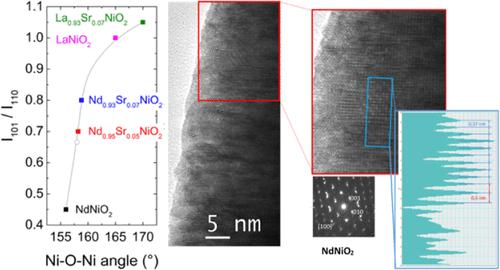揭示稀土(La vs Nd)在Ni+基层状镍酸盐中的关键作用:对结构和物理性质的影响
IF 7
2区 材料科学
Q2 CHEMISTRY, PHYSICAL
引用次数: 0
摘要
我们报道了在高氧压力(T = 900°C, PO2 = 250 bar)下合成大块RE1-xAxNiO3 (RE = La, Nd; A = Sr, Ca)钙钛矿相,并确定了相纯样品的溶解度极限为x = 0.07。这一溶解度极限是由所研究的各种RE和A组合共有的,可能受到Ni4+含量(t2g6)的限制,无论RE和A原子的大小如何,Ni4+的电子效应都限制了掺杂。碱土(空穴)掺杂导致RE1-xAxNiO3的单元胞体积减小,尽管存在较大的碱土原子,并且在RE = Nd (Nd1-xAxNiO3)的情况下,正交畸变增加。将钙钛矿相与2 mol CaH2混合,在二次真空密封的试管中低温(250℃)处理,经拓扑定向还原后得到RE1-xSrxNiO2无限层。用热重分析法准确测定了化合物的氧化学计量量。我们发现,尽管钙钛矿母化合物RENiO3显示出高结晶质量,但无论稀土(Nd或La)的性质如何,在还原的NdNiO2无限层中存在明显的层错,这是通过使用同步辐射的x射线衍射测量确定的。高压衍射实验进一步证明了压力对这些层错影响的衰减作用,并利用断层程序对这些层错进行了部分模拟和建模。当Sr2+掺杂率为7%或以La代替Nd时,这些缺陷几乎不存在。在NdNiO2的情况下,HRTEM分析证实了这种层错的存在。这些层错在还原无限层成分中更为明显,母层钙钛矿结构更扭曲,通过Ni-O-Ni角偏离180°来测量,因此在还原后钙钛矿结构扭曲与层错发生之间建立了记忆效应。钙钛矿结构变形越多,层错率越大。最后,我们报道并讨论了基于La和nd的无限层组合物的磁性能、电阻率和比热及其结构性质。更具体地说,我们揭示了Nd3+的f电子对比热的贡献,并通过磁性和比热测量讨论了LaNiO2中自旋玻璃态的可能特征。本文章由计算机程序翻译,如有差异,请以英文原文为准。

Unveiling the Key Role of Rare-Earth (La Versus Nd) in Ni+-Based Layered Nickelates: Impact on Structures and Physical Properties
We report the synthesis of bulk RE1–xAxNiO3 (RE = La, Nd; A = Sr, Ca) perovskite phases under high oxygen pressure (T = 900 °C, PO2 = 250 bar) and identify a solubility limit of x = 0.07 for phase-pure samples. This solubility limit, shared by the various RE and A combination investigated, is likely constrained by the Ni4+ content (t2g6) whose electronic effect limits doping, regardless the size of RE and A atoms. Alkaline earth (hole) doping induces a decrease in the volume of the unit cell of RE1–xAxNiO3, despite the presence of larger alkaline earth atoms, and an increase in the orthorhombic distortion in the case of RE = Nd (Nd1–xAxNiO3). After topotactic reduction, RE1–xSrxNiO2 infinite-layers were obtained by mixing the perovskite phase with 2 mol CaH2 in a tube sealed under secondary vacuum and treated at low temperature (250 °C). Thermogravimetric analysis was used to determine the oxygen stoichiometries of the compounds with accuracy. We find that while the perovskite parent compound RENiO3 displays a high crystalline quality, regardless the nature of the rare-earth (Nd or La), marked stacking faults are present in the reduced NdNiO2 infinite-layer, as determined by X-ray diffraction measurements using synchrotron radiation. The high-pressure diffraction experiment further demonstrates the role of pressure in attenuating the effect of these stacking faults that were also partially simulated and modeled using the FAULTS program. These defects are virtually absent for Sr2+ doping at 7% or when Nd is replaced by La. The occurrence of such stacking faults is confirmed by HRTEM analysis in the case of NdNiO2. These stacking faults are more pronounced in the reduced infinite layer compositions for which the parent perovskite structure is more distorted, as measured by the departure of the Ni–O–Ni angle from 180°, establishing therefore a memory effect between the distortion of the perovskite structure and the occurrence of stacking faults after reduction. The more the perovskite structure is distorted, the greater the stacking fault rate. Finally, we report and discuss the magnetic properties, the electrical resistivity, and the specific heat of La and Nd-based infinite layer compositions with respect to their structural properties. More specifically, we shed light on the contribution of f-electrons of Nd3+ to the specific heat and discuss the possible signature of spin glass state in LaNiO2 through magnetic and specific heat measurements.
求助全文
通过发布文献求助,成功后即可免费获取论文全文。
去求助
来源期刊

Chemistry of Materials
工程技术-材料科学:综合
CiteScore
14.10
自引率
5.80%
发文量
929
审稿时长
1.5 months
期刊介绍:
The journal Chemistry of Materials focuses on publishing original research at the intersection of materials science and chemistry. The studies published in the journal involve chemistry as a prominent component and explore topics such as the design, synthesis, characterization, processing, understanding, and application of functional or potentially functional materials. The journal covers various areas of interest, including inorganic and organic solid-state chemistry, nanomaterials, biomaterials, thin films and polymers, and composite/hybrid materials. The journal particularly seeks papers that highlight the creation or development of innovative materials with novel optical, electrical, magnetic, catalytic, or mechanical properties. It is essential that manuscripts on these topics have a primary focus on the chemistry of materials and represent a significant advancement compared to prior research. Before external reviews are sought, submitted manuscripts undergo a review process by a minimum of two editors to ensure their appropriateness for the journal and the presence of sufficient evidence of a significant advance that will be of broad interest to the materials chemistry community.
 求助内容:
求助内容: 应助结果提醒方式:
应助结果提醒方式:


